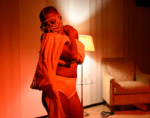
United States of Urgency: Migrant Bodies on the Move
by L. Graciella Maiolatesi
My stomach growls as I arrive to see Supper, People on the Move! presented by Cardell Dance Theater. This process, which began in 2012 as a reflection of Artistic Director Silvana Cardell's personal experience, had its Philadelphia premiere in 2015. It has evolved into a living body of work that illustrates immigrant journeys, simultaneously humanizing migrant bodies. I admire Cardell’s passion for incorporating the personal and political into her work, carving space for multiple narratives including those of my mentor and peers from Temple University—Merian Soto, Ama Gora, and Hassan Syed—performing tonight. The lobby of Drexel University’s URBN Center Annex has been made into a makeshift gallery. Photos of multiple immigrants and their narratives—written in both English and their native languages—filling the space. I begin reading these but am interrupted by an authoritative voice that halts the large crowd in the lobby.
“Tickets out! If you have a green ticket line up here, yellow there, red behind this line here. Hurry up!”
Immediately we are transported from a cozy lobby to the Department of Immigration. I anxiously fumble for my ticket as we are herded into our correct lines, locating it just in time for it to be snatched from my hand by someone who refuses to meet my gaze, ushering me into the performance space. A long rectangular table is set with a pristine white tablecloth and bread baked with love, but the black box theater itself is dark, cold, and filled with fog. Onstage a performer (William Robinson) juggles a soccer ball, stopping every now and then to point to a far-off player invisible to us. An elder in red (Soto) enters the space, filling the glasses on the table with water. The two embrace, sit, and are joined by the rest of the ensemble (Gora and Syed, with Megan Midgley, Mackenzie Morris, Zachary Svoboda, and Maria Urrutia). Seated, they share intentional eye contact, voicing with their eyes what they cannot verbally communicate: “We have a long journey ahead of us—see you on the other side.” They gently reach for each other’s hands; twisting and turning, their line contorts itself into uncomfortable positions, but never breaks, and it is clear that this bond is forever.
A ticking rhythm has been building in the space, reminding the audience—still filing in from being detained outside—to quickly arrive to a seat. But the performers wait for no one. For this is not a performance but lived experience, ancestral memory, journey yet to come. It is an active fear that currently permeates the borders of our nation where children sit in cages.
The performers are on the move and there is no stopping them. Left alone, the elder in red, danced by Soto, carefully folds the white tablecloth as if tucking in a child. This level of care is seen throughout the work—caressing a cheek, adjusting another’s sweater, extending a hand of support—revealing a tenderness in strength that we often forget. This journey requires strength of mind, body, and spirit.
Cardell brilliantly uses tables to locate the multiple immigrant narratives present in the space. Drawing from both the literal and metaphoric, Cardell’s dancers transform the tables from sites in which they break bread to vehicles moving at break-neck speeds. The tables become freight trains, boats, walls, and borders for the ensemble to transport themselves. Throwing, rolling, climbing, running, and jumping over, under, and through, the ensemble fearlessly embodies the harrowing reality of untold immigrant narratives. In an unforgettable moment, the dancers take turns forcefully slamming together two tables serving as “doors.” They scream “GO!” to other members who, in a three second time span, throw themselves through the gap between the colliding tables. I reflect on the state of urgency that some immigrants must embody to survive: there is no time to think, breathe, or hesitate.
Soto, the elder in red hugs someone who has survived this journey. Bundles of food are given to the audience as an invitation to share a meal after the performance. This honors the care of women from Veracruz, Las Patronas, who began the custom of preparing food bundles to throw to migrants as their trains passed by. Biting into the taco prepared for me, I listen to those I sit with at the table: many of them are migrants or children of immigrants. Syed speaks about Cardell’s creative process, explaining that the choreographic explorations are “impossible tasks” if attempting to do them alone, hinting at the proverb, “If you want to go fast go alone. If you want to go far go together.” Cardell’s work has created a moment of restoration for the people on the move, but the journey is not over.
Supper, People on the Move!, Cardell Dance Theater, Drexel University URBN Center Annex. November 8-10.
By L. Graciella Maiolatesi
November 18, 2019









